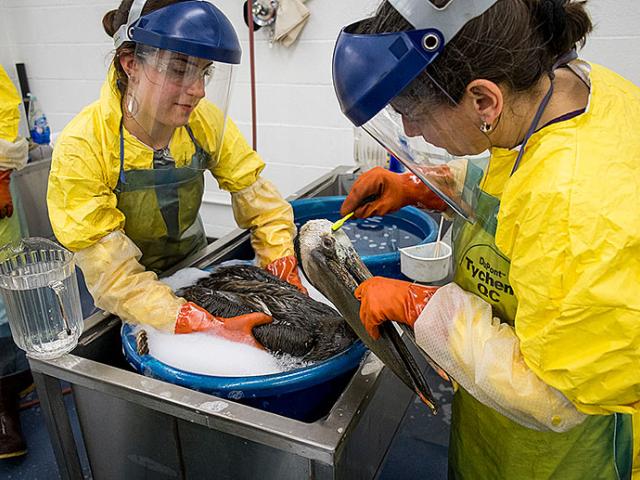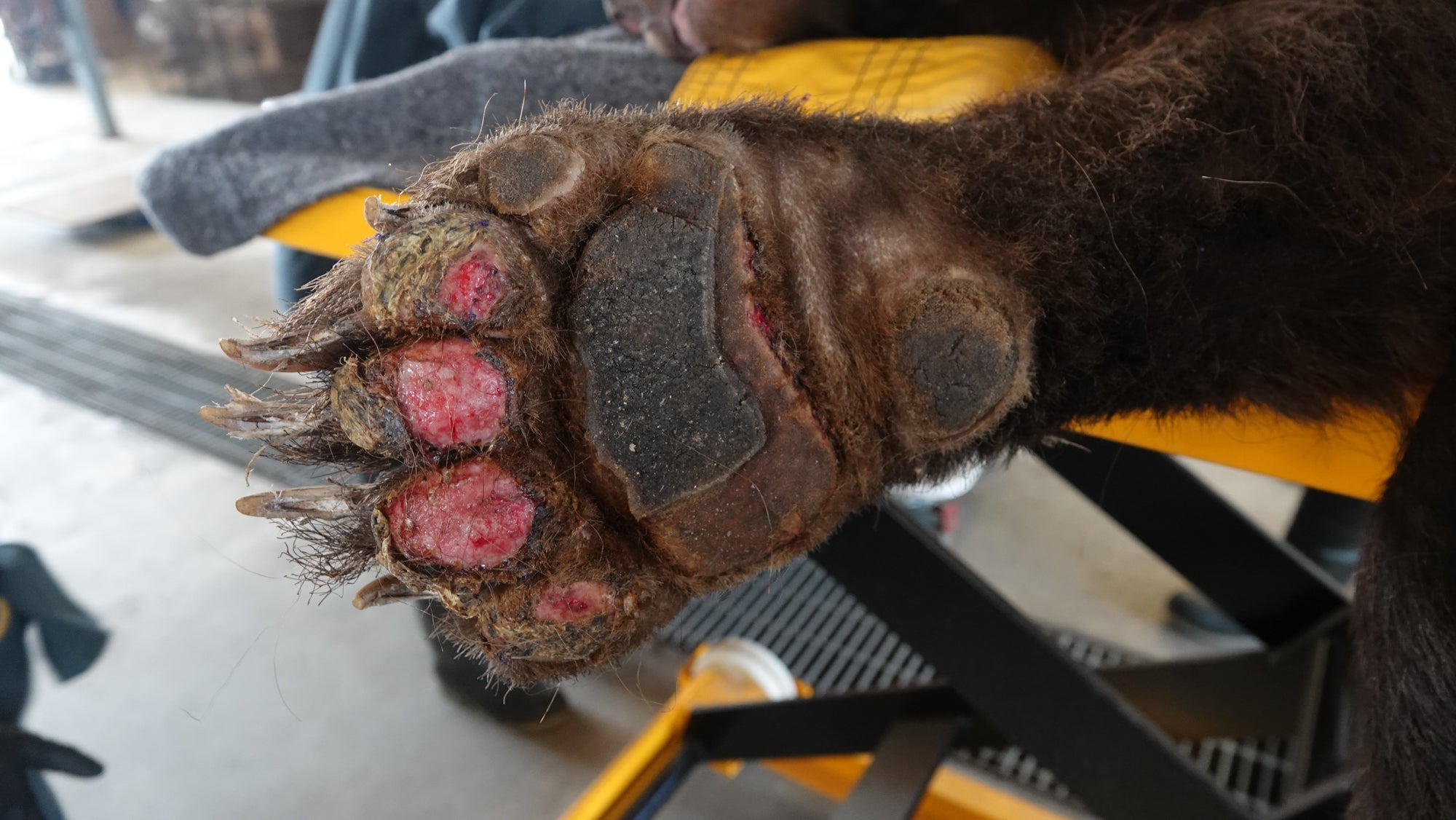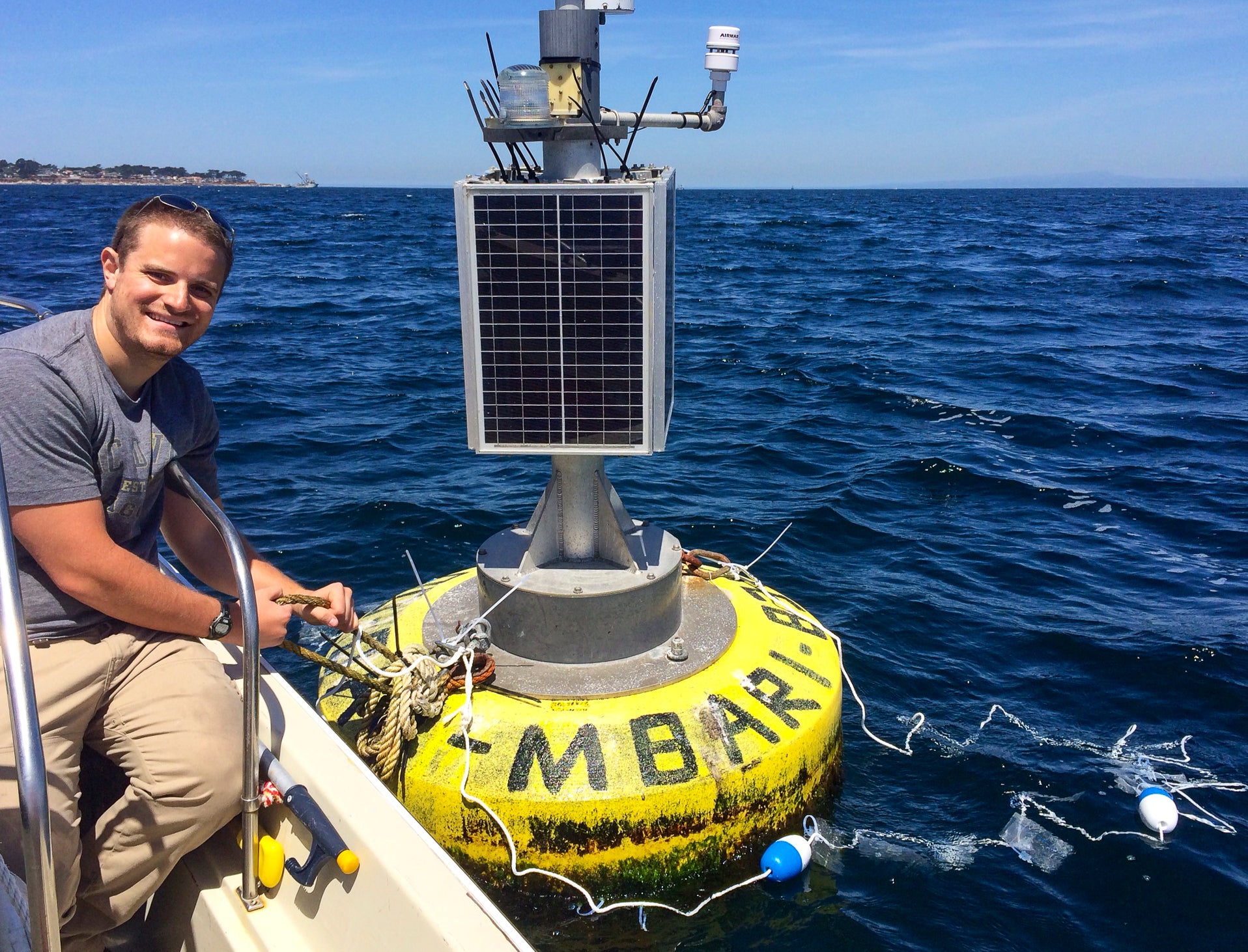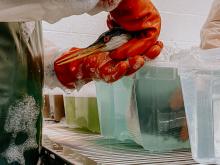It’s early October in Southern California, and Danene Birtell is psyching herself up to wash an oiled snowy plover.
“I can do this. I’ve got this,” she’s saying to herself.
She does have it. Birtell has washed hundreds of birds during her career as a wildlife responder with the Oiled Wildlife Care Network, which is managed by the University of California, Davis. But this little shorebird is extra special.
It’s a western snowy plover, which is listed as federally threatened under the Endangered Species Act and considered a “species of special concern” in California. It’s one of the 36 live animals — including six other snowy plovers — rescued by OWCN wildlife responders during the Orange County oil spill.


The OWCN is led and managed by the UC Davis School of Veterinary Medicine in partnership with the California Department of Fish and Wildlife – Office of Spill Prevention and Response (CDFW-OSPR). The network and its 44-member organizations spring into action any time an oil spill occurs in California.
When an underwater oil pipeline off the coast of Huntington Beach began leaking in early October, releasing around 25,000 gallons of oil into the ocean, OWCN responders dropped everything and came to Orange County to lead the wildlife rescue effort.
“We always do the best we possibly can for all the oiled birds and animals we treat,” said Birtell, a UC Davis care and processing group supervisor for OWCN. “And anytime you have a species that is threatened or endangered and you know their populations are suffering, there is this underlying pressure. But that can get in the way of doing what you know how to do.”
So with a clear mind, Birtell steps into her rubber boots, pulls purple gloves over her hands, and gets to work washing a bird whose life was already threatened before crude oil ever ruffled its feathers.
A bird’s life
At Bolsa Chica Ecological Reserve, the sun glints off a minnow’s back in the shallow water of this saltwater marsh. Sage, cattails, goldenbush and other plants dot the landscape in shades of yellow, red, green and brown. Terns fly above as ducks congregate in the water. Pacific Coast Highway traffic whooshes by at a gentle murmur in the distance, and beyond it, the Pacific Ocean crashes ashore at Huntington Beach.


It’s amid this place’s sandy nesting grounds that the bird in Birtell’s soapy hands began its life.
Called “yn:oy” in the formal records, this snowy plover was part of a nest abandoned at Bolsa Chica. Her egg, cream-colored and black-speckled to camouflage in the sand, was found and brought to the nearby Wetlands and Wildlife Care Center, an OWCN member organization. In their care, the plover hatched, was reared, and released in 2018.
That winter, she was spotted at Huntington State Beach, where she has become a local. The plover has bred there multiple times every year since 2019, contributing to her species’ survival.
In the challenging year that was 2020, her nest was vandalized, just days before her eggs were expected to hatch. Then in 2021, the oil came.
Thankfully, so did the OWCN.
What oil can do
Seabirds are uniquely sensitive to oil. Their feathers work much like a drysuit, keeping their bodies warm and dry while in the water. When their feathers are coated in oil, water reaches their skin, making them cold; if the oil is not removed, they can quickly die.
Furthermore, as birds preen themselves to get rid of the oil, they ingest it, harming their organs and disrupting their ability to eat and drink.
Unlike seabirds, shorebirds such as snowy plovers are less prone to hypothermia, but if heavily coated, they can also die from oil exposure, low body temperature, and increased metabolism.
“The greatest factor for the survival of oiled animals relates to how quickly we, as wildlife responders, can get out, get animals into our care, and start to reverse the effects of oiling,” said Michael Ziccardi, director of the OWCN and of the One Health Institute at UC Davis. He has responded to more than 75 oil spills in his career.
The OWCN has upwards of 1,600 pre-trained responders and a dozen facilities throughout the state ready to care for oiled wildlife. It’s a level of preparedness unparalleled in the world and a model for global oil-spill response. For oiled animals, the network can mean the difference between life and death — a distinction that carries extra weight for threatened and endangered species.
The greatest factor for the survival of oiled animals relates to how quickly we, as wildlife responders, can get out, get animals into our care, and start to reverse the effects of oiling.” Michael Ziccardi, director of the OWCN
When “yn:oy” was found on the sand at Huntington Beach on Oct. 7., a few days after the spill began, network wildlife responders quickly brought the snowy plover to the same place she hatched — Wetlands and Wildlife Care Center, the designated stabilization facility for this spill. Once warm and nourished, she was transported to the Los Angeles Oiled Bird Care and Education Center, a primary care facility in San Pedro managed during non-spill times by International Bird Rescue, an OWCN member.
The wash

When birds first arrive at the care facility, they get a full medical exam. They then wait about 48 hours to make sure each animal is strong enough to move to the next stage: cleaning.
Two days after her rescue, “yn:oy” is ready. Birtell and Sam Christie, a UC Davis OWCN strike team leader, bring her into the washing room along with another oiled snowy plover.
The room smells of dish detergent. Clear tubs of blue sudsy water await the plovers. Birtell holds “yn:oy” between her gloved fingers. All is quiet in the room but for a background rush of running water and the sound of rubber boots slapping against the damp floor.
It’s important to be quiet to avoid stressing the birds. Birtell and Christie first apply a pre-treatment solution to help the oil come off more easily. Using a long Q-tip and small sponge, they dab the tiny birds with the solution as if painting them.
When they move on to the washing tubs, UC Davis OWCN Response veterinarian Jamie Sherman leans quietly over to explain how this is nothing like washing a pet.
“Anytime we’re handling our wild animals, whether it be a plover or a grebe, it’s a very stressful situation because they don’t want to be around people,” Sherman said. “With our dogs, we get all up in there. We’re moving the fur around.
“But with the birds,” Sherman continued, “we don’t want to damage their feathers, yet we want to make sure that we get a really good wash. So we use our hands to move the water across their bodies and underneath the feathers, almost like a little Jacuzzi.”
It’s gentle, yet fast, work. They aim to have the birds washed, rinsed, dried and back in their enclosure within 10 minutes so the birds’ stress lasts no longer than necessary.
The plovers seem calm, but Birtell and Christie say that’s not likely the case. These birds want out of their hands.
“They have no idea we’re helping them,” Christie said of oiled birds in general. “They hate us. It’s not like kittens. We’re like aliens to them; this probably feels like an abduction.”
“We think of it as, ‘This is the worst day of this bird’s life’,” J.D. Bergeron, CEO of International Bird Rescue, said earlier in the week. “You want that bird only to struggle through this one rough moment and move on to get better.”
The birds will have another exam before they graduate to the outside enclosures, where they’ll need to show that they’ve regained their waterproofing ability and that they can spend two nights outside before they are released to their natural environment.

‘Ploverland’
In the meantime, the OWCN team tries to make this environment as comfortable as possible for all the birds, but especially for these threatened snowy plovers. Some responders affectionally call where the little birds are housed “Ploverland,” and they are clearly the VIPs of the place.
Although this is no spa and the birds would much rather be home, their accommodations are tastefully appointed with plants and a green-and-white sandy color scheme worthy of Pinterest. Only the best food is served — an all-they-care-to-eat buffet of squiggling mealworms and other insects. Their enclosure temperature is set at the perfect comfort level.

At times, their feathers receive a gentle misting — water beading on their feathers indicates their waterproofing has returned. There is also, of course, a pool. And at night, a sound machine plays ocean music through the room as they slumber, providing at least some sense of home.
“They are out of their natural habitat and have an unfamiliar substance on them,” Birtell said. “They don’t feel good. They might be cold. So we just really want to give them the support they need to recover.”
Beyond care
The OWCN is not only a care network, it’s also a research one focused on constant improvement. After every oil spill, the group holds several “hot washes,” where they discuss with OWCN members, CDFW-OSPR staff, and within the UC Davis Management Team what went well and what could be improved upon for the next spill. They conduct research ranging from improving medical records and nutrition techniques to broader-reaching studies about long-term survival rates of oiled wildlife.
Much has been learned about improving care for oiled wildlife since the network’s formation in 1994. Their average success rates for treating oiled wildlife are up from about 25-50% in the 1990s to 50-75% today.

Beyond California
If one must be an animal covered in oil, California is an ideal place because of the OWCN. Yet the world is large, and oil is everywhere. In the decade between 2010-2020, an average of 1.8 large oil spills from tankers occurred globally each year, along with several smaller spills.
The OWCN is showing the difference a coordinated, prepared and timely response can make for wild animals caught in human-created spills. That is why UC Davis is also actively involved in global readiness and response.
Ziccardi chairs the Global Oiled Wildlife Response System Project, made up of the world’s leading organizations dedicated to improving global readiness for oil spills. Through this role, UC Davis actively shares the lessons learned and expertise applied in Orange County to wherever wildlife may be at risk from oil.
The price of oil
It’s important to celebrate when animals get a second chance at life. It’s also important to remember those who didn’t. There were 86 dead animals collected during the spill — cormorants, grebes, gulls, dolphins, sea lions and more. Post-mortem examinations have yet to attribute all of their deaths to oil, but the spill clearly impacted many of them.
Wildlife pays a high price for our reliance on oil. That aspect of oil can’t be washed away. And individual animals increasingly matter, especially within struggling populations. For those lucky enough to be rescued, this network of wildlife responders can make all the difference.
Sweet release
It’s fair to say “yn:oy” is not thinking about any of that as she’s placed into a box and transported back to Huntington Beach on her release day.

Maybe she hears the waves and can smell the ocean. Her eyes blink at the sky as the lid opens. She hops out. Tiny footprints hit the sand. She lifts her wings and flies, home.
“We feared she would be one of the oiled plovers,” Lana Nguyen, an environmental scientist with California State Parks Orange Coast District, said in late October. “But I’m glad she has been cleaned, released, and is back to her usual. I spotted her yesterday morning in the plover roost at Huntington State Beach — a welcome resighting.”

Related Stories
Oiled Wildlife Care Network Comes Full Circle in Orange County
More than 80 responders from 14 of OWCN’s 44 member organizations worked to rescue, clean and release birds and animals impacted by the oil spill.

Wildlife Experience the High Price of Oil
A ruptured pipeline in Santa Barbara in 2015 spilled 100,000 gallons of oil, requiring the OWCN to step in and rescue brown pelicans, California sea lions and elephant seals.

Wildlife Disaster Network Mobilizes Aid for Burned, Injured Wildlife
Modeled on the OWCN, this partnership between UC Davis and the California Department of Fish and Wildlife steps in to help burned and injured animals.

Why Do Seabirds Eat Plastic? The Answer Stinks
An olfactory cue is confusing birds to think that marine plastic is food; researchers might be able to develop new strategies to address the ocean's plastic problem.
Media Resources
Kat Kerlin, UC Davis News and Media Relations, 530-752-7704, kekerlin@ucdavis.edu


